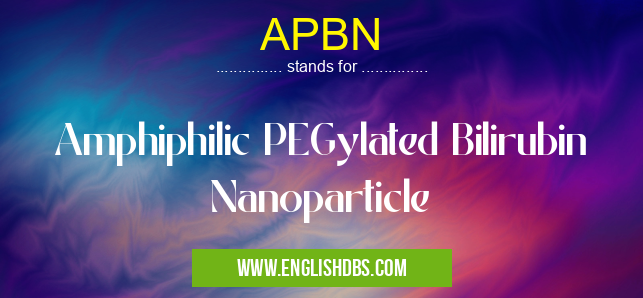What does APBN mean in UNCLASSIFIED
APBN stands for Amphiphilic PEGylated Bilirubin Nanoparticle. It is a novel nanomedicine platform based on the natural pigment bilirubin, which is known for its antioxidant and anti-inflammatory properties. APBNs are engineered to enhance bilirubin's therapeutic potential by improving its solubility, stability, and targeting capabilities.

APBN meaning in Unclassified in Miscellaneous
APBN mostly used in an acronym Unclassified in Category Miscellaneous that means Amphiphilic PEGylated Bilirubin Nanoparticle
Shorthand: APBN,
Full Form: Amphiphilic PEGylated Bilirubin Nanoparticle
For more information of "Amphiphilic PEGylated Bilirubin Nanoparticle", see the section below.
Composition and Properties
APBNs are composed of a hydrophobic bilirubin core surrounded by a hydrophilic polyethylene glycol (PEG) shell. The PEG shell provides water solubility and prevents aggregation, ensuring long-term stability in biological fluids. The amphiphilic nature of APBNs allows them to interact with both hydrophobic and hydrophilic environments, facilitating their uptake by cells.
Therapeutic Benefits
APBNs have demonstrated a wide range of therapeutic benefits, including:
- Antioxidant activity: Bilirubin is a potent antioxidant that protects cells from oxidative damage. APBNs deliver bilirubin directly to target sites, enhancing its antioxidant capacity.
- Anti-inflammatory activity: Bilirubin has anti-inflammatory properties that can reduce inflammation and tissue damage. APBNs deliver bilirubin to inflamed tissues, mitigating inflammatory responses.
- Neuroprotective activity: Bilirubin protects neurons from damage caused by oxidative stress and excitotoxicity. APBNs have shown promise in treating neurodegenerative diseases such as Alzheimer's and Parkinson's.
- Anti-cancer activity: Bilirubin has been shown to inhibit cancer cell growth and metastasis. APBNs deliver bilirubin to tumors, enhancing its anti-cancer effects.
Clinical Applications
APBNs are being investigated for a variety of clinical applications, including:
- Treatment of oxidative stress-related diseases: APBNs can protect against diseases caused by oxidative stress, such as cardiovascular disease, chronic kidney disease, and neurodegenerative disorders.
- Treatment of inflammation: APBNs can alleviate inflammation in conditions such as arthritis, inflammatory bowel disease, and sepsis.
- Treatment of neurodegenerative diseases: APBNs may provide neuroprotective effects in Alzheimer's, Parkinson's, and other neurodegenerative diseases.
- Treatment of cancer: APBNs can inhibit tumor growth and metastasis, offering potential for cancer therapy.
Essential Questions and Answers on Amphiphilic PEGylated Bilirubin Nanoparticle in "MISCELLANEOUS»UNFILED"
What is APBN?
APBN stands for Amphiphilic PEGylated Bilirubin Nanoparticle. It is a nanoparticle-based formulation of bilirubin, a yellow pigment naturally produced by the body. APBN is designed to enhance the therapeutic properties of bilirubin, particularly its antioxidant and anti-inflammatory effects.
What are the potential applications of APBN?
APBN is being explored for various therapeutic applications, including neuroprotection in conditions like stroke and Alzheimer's disease, cardiovascular diseases, and inflammatory disorders. Due to its antioxidant and anti-inflammatory properties, APBN has shown promise in mitigating oxidative stress and reducing inflammation.
How is APBN different from traditional bilirubin formulations?
Traditional bilirubin formulations often face challenges due to their poor solubility and stability. APBN, through its unique PEGylation and amphiphilic nature, overcomes these limitations. PEGylation enhances its solubility and prevents aggregation, while the amphiphilic properties facilitate the delivery of bilirubin across biological membranes.
What are the advantages of using APBN?
APBN offers several advantages over traditional bilirubin formulations:
- Enhanced solubility and stability
- Improved delivery and bioavailability
- Increased therapeutic efficacy
- Reduced potential for adverse effects
Is APBN safe for use?
The safety profile of APBN is currently being evaluated in preclinical studies. Further research is necessary to determine its safety and toxicity in humans.
Final Words: APBNs are a promising nanomedicine platform with a wide range of therapeutic applications. Their unique combination of antioxidant, anti-inflammatory, neuroprotective, and anti-cancer properties makes them a valuable tool for treating various diseases. Ongoing research continues to explore the full potential of APBNs, paving the way for novel therapeutic strategies.
